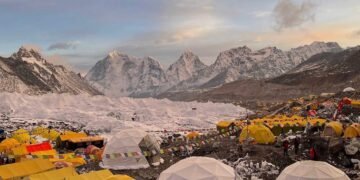Pritam Bhattarai
Kathmandu, Dec 28: Climbing Mount Everest is like walking on thin ice. It is as the routes go through the Khumbu Icefall, the most dangerous route for its ever changing ice structures and unpredictable weather conditions.
Seven Summit Treks, a leading Kathmandu-based trekking and expedition company, is organising the Everest Camp II expedition in the year 2024.
To make the venture safe and a success, SST has guaranteed the management of experienced mountain guides with extensive knowledge about mountains and a proven safety record. Besides, it will manage required logistics and supplies, it said.
Camp II
The journey starts at Everest Base Camp at an elevation of around 5,364 metres (17,598 feet). Climbers have to deal with the Khumbu Icefall (5,486 metres), a challenging route with shifting ice structures, deep crevasses, high and massive ice cliffs before reaching Camp I at a height of about 6,065 metres (19,900 feet).
Climbers and guides often opt to navigate the treacherous and challenging route during the night to avert any potential hazards like avalanche as it is known for its unstable and constantly shifting ice structures.
After crossing the icefall, climbers reach the Western Cwm, a wide valley surrounded by Everest and Lhotse and Camp I.
Passing through Camp I navigating the steep Lhotse Face comes Camp II. Camp II lying on a rocky part of the glacier is considered a safe, comfortable and well-supplied camp where climbers and guides can spend several days acclimatising to the higher altitudes or waiting for the right weather conditions to start their journey for the top.
The Camp is also taken as a training ground or rest stop from where climbers launch their journey to Camp III (23,600 feet) and Camp IV (25,938 feet). Many climbers tend to reach Camp II without supplemental oxygen. Some use supplemental oxygen on the way to Camp III.
However, hard work comes big rewards. Climbing to Camp II presents a mix of excitements ranging from navigating the stunning ice formations.





















